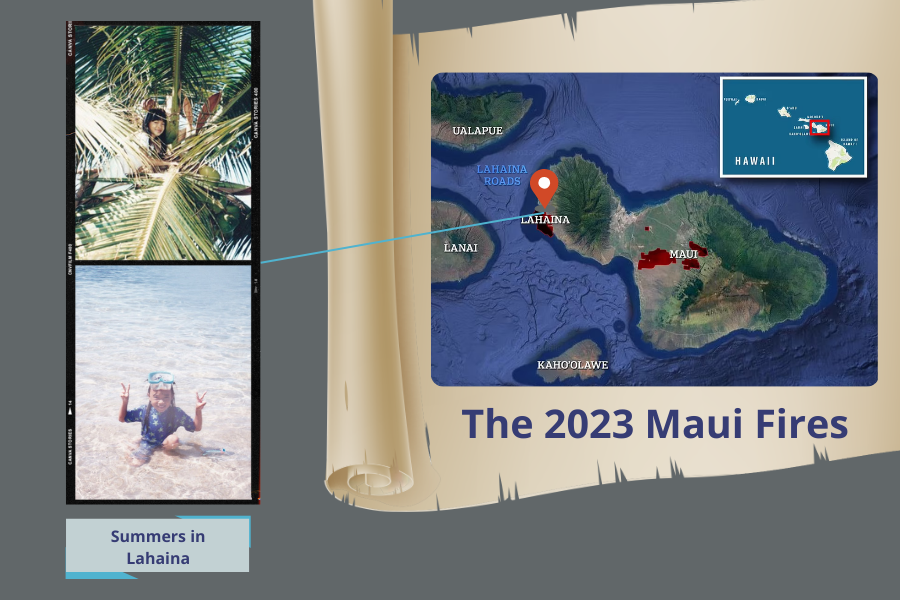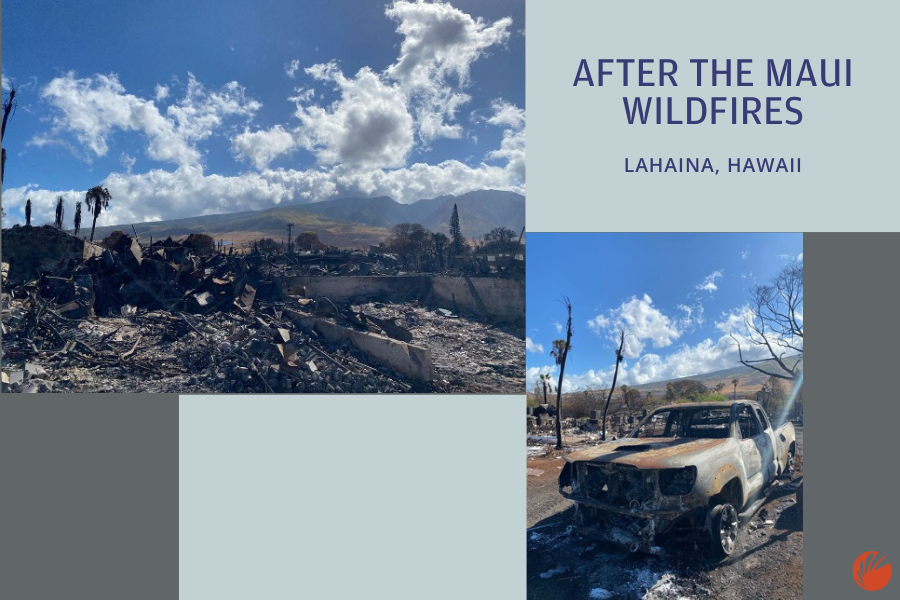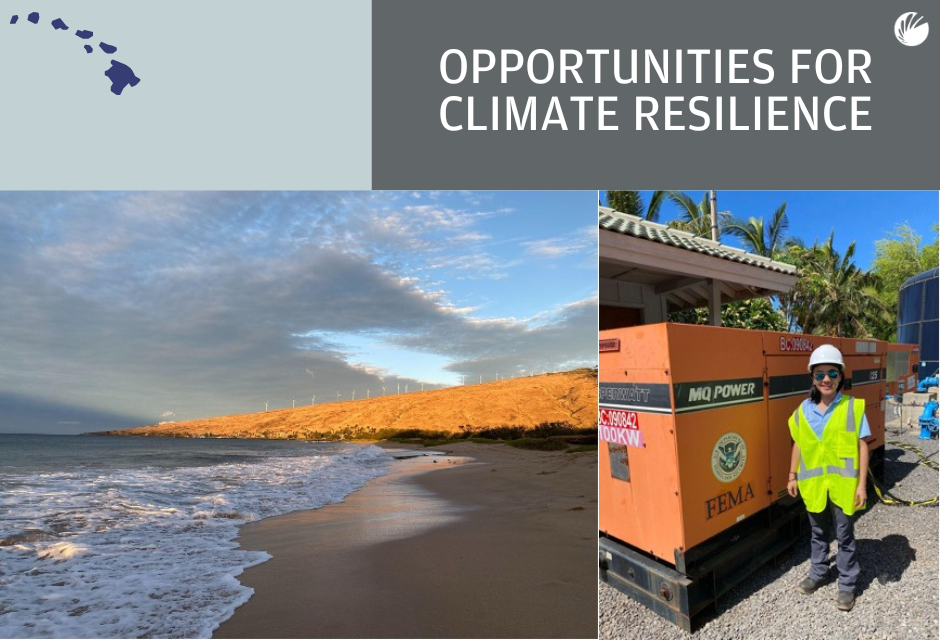Climate disasters—such as floods, heat waves, and sea level rise—have increased in intensity and frequency, disrupting livelihoods and communities all over the world. While I have centered my career on the climate crisis for 10 years, it had not crystallized so personally—and painfully—until the catastrophic Maui wildfires of August 2023.
Three generations of my family have lived on the Hawaiian island for over 120 years. I spent blissful childhood summers in the historic town of Lahaina, picking coconuts on my grandparents’ home on Front Street, seeing a kaleidoscope of fish and coral off Baby Beach, and making leis out of fragrant plumeria flowers.

Last fall, I was in the midst of planning my wedding in Lahaina, where my parents also got married, and had secured a venue. Only two days after booking accommodation for the entire wedding party, wildfires ravaged the island. The wildfires were fueled by a deadly combination of climate events:
- The spread of invasive plants such as guinea grass
- A severe drought that dried vegetation into tinder
- Winds exceeding 80 mph—exacerbated by Hurricane Dora—which fanned the flames
I started calling my elderly family members living there. They went straight to voicemail. News reported that communication lines were down. We heard nothing for 48 hours—waiting in agony 5,000 miles away.
At last, we heard that my family evacuated safely in time. But they lost all their possessions: their homes, vehicles, family heirlooms, and more. We also saw that the wedding venue we booked, a temple built over 90 years ago, burned down. What began for me as a celebration of joy abruptly changed into a tragedy of horror.
After the Maui Wildfires: Driving Climate Solutions
Two and a half weeks after the wildfires, I joined an on-the-ground deployment with WSP, my employer at the time, delivering emergency power generators to critical facilities, such as hospitals and community centers, across Maui.
During that mission, I visited Lahaina in what seemed like an out-of-body experience. I felt like a puppet going through the motions, unable to reconcile what my eyes were seeing, unable to orient myself in the town I knew so well.

The Lahaina wildfire was the worst natural disaster in the State of Hawaii’s history and the deadliest U.S. wildfire in the last century. All told, 101 people lost their lives and two remain missing. The wildfire destroyed or damaged over 2,200 buildings, mostly homes. Over 800 businesses were disrupted, losing about $2.7 million per day. Historical artifacts—such as the flag that was lowered after the Kingdom of Hawaii was overthrown—can never be replaced.
It dawned on me that rebuilding Lahaina would take many years and billions of dollars.
- The downside: reconstruction—if cowed by outside interests with deep pockets rather than cultivated by community members—could turn Lahaina into another tourist town and a cautionary tale of climate gentrification
- The upside: Lahaina’s recovery could be a chance to invest in and deploy climate-resilient, community-driven solutions that could even prevent such a disaster from happening again
Federal Climate Investment Opportunities and Challenges
The Maui wildfires ignited something in me. I decided to focus my career on climate investment opportunities, partly to build capacities of vulnerable communities like Lahaina to withstand the climate crisis.
Now marks an unprecedented era for federal climate investment. Federal opportunities like grants, loans, and tax incentives have mushroomed under the 2022 Inflation Reduction Act (IRA) and the 2021 Infrastructure Investment and Jobs Act (IIJA). They are expected to spur $1.25 trillion toward climate-related projects in the next five to 10 years across sectors, such as energy, transportation, and water.
With this influx of federal climate investments, eligible applicants are struggling with the pace and scale of applying for funds and implementing them. As Director of the State Funding Readiness Project (SFRP), my team at Hua Nani Partners delivers 100% pro bono technical assistance to state, territorial, and local governments so they can leverage federal IRA and IIJA grants. We have helped jurisdictions successfully secure over $800 million in federal dollars for projects that not only reduce greenhouse gas emissions but also advance climate equity priorities.

The jurisdictions we support have high ambitions to meet their climate and energy goals, but they lack sufficient capacity and resources to capitalize on these federal investment opportunities. They are hampered by:
- Small staff who are overstretched
- Limited budgets to hire consultants or contractors
- Demanding and overlapping timelines of federal program applications
- Inexperience with bureaucratic federal requirements
Moreover, we have found that jurisdictions often struggle to embed climate equity and environmental justice in their projects and processes. Low-income and disadvantaged communities—historically and currently on the frontlines of climate impacts and environmental burdens like air pollution—are too often deterred from engagement and decision-making, and they receive disproportionate federal funding and resources.
ISC’s Expertise in Federal Funding for Climate Equity
Federal climate investments are significant opportunities to correct these historical inequities, deliver much needed technical assistance, and invest in divested communities. Through the implementation of two U.S. Environmental Protection Agency (EPA) grants totaling $60 million, ISC aims to remove barriers and improve accessibility for divested communities with environmental justice concerns.
EPA Environmental Justice Thriving Communities Technical Assistance Center Program
As one of three national Thriving Communities Technical Assistance Centers (TCTAC), ISC will serve regional TCTAC centers throughout the country, which connect divested communities with federal resources and support the creation of partnerships to expand the reach and impact of federal funds. ISC will cooperate with partners to:
- Provide technical assistance to communities on navigating, applying for, and managing federal grant funding
- Facilitate community engagement, including with limited English-speaking participants
- Create communication channels for communities to have direct access to resources and information
Learn more about ISC’s role in the EJ TCTAC program.
EPA Environmental Justice Thriving Communities Grantmaking Program
As one of 11 National Grantmakers, ISC will make it easier for small, community-based organizations—particularly resource-constrained ones supporting underserved and marginalized populations—to access federal environmental justice funding. ISC will work with partners to:
- Reduce barriers to the federal grants application process
- Increase the efficiency of awarding environmental justice grants
- Award environmental justice subgrants
- Provide resources and technical support to communities
Learn more about the EJ Grantmaking Program.
Both these projects will build capacity within and direct federal funding toward community-based organizations. As an ISC Board Member, I believe the organization is uniquely positioned to ensure that community members’ voices remain centered in climate solutions. Through our bottom-up approach—where divested communities are partners in co-creating, implementing, and scaling climate change solutions—ISC delivers climate resilience projects that are of communities, for communities, and by communities.
I learned first-hand the devastation that climate change unleashes onto communities. As we rush to capitalize on unprecedented levels of federal climate investments, it is critical to avoid exacerbating existing inequities. As we deploy solutions that reduce greenhouse gas emissions and build long-term resilience, let us simultaneously advance climate equity and environmental justice, so that we may all benefit from a more sustainable world.
About the Author

Taryn Akiyama is an ISC Board member who is passionate about the intersection of investment, policy, and global affairs in enhancing collaboration and scaling impact for climate change and clean energy. At Hua Nani Partners, she is Director of the State Funding Readiness Project, delivering pro bono technical assistance to help jurisdictions leverage federal investment opportunities to reduce greenhouse gas emissions and advance climate equity.
Formerly, Taryn worked as a consultant at Climate Finance Advisors, member of WSP, and served as a political appointee under Governors Jerry Brown and Gavin Newsom at the California Governor’s Office of Planning and Research. She holds a Master of Environmental Management from the Yale School of the Environment and a certificate in Sustainability and Climate Risk from the Global Association of Risk Professionals.

